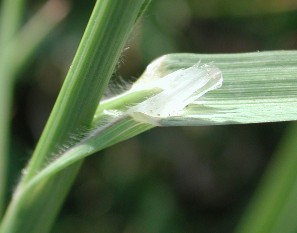Scientific name: Bromus catharticus Vahl
Synonyms: Bromus unioloides Kunth.; Bromus willdenowii Kunth.; Ceratochloa unioloides (Kunth) Beauv.Common name:Prairie grassFamily: PoaceaeOrigin:Native of South America. Habit:Annual tufted grass, with pale green leaves and an upright habit, up to 1 m in height. Habitat:A useful winter pasture grass, this species has become a weed of untended areas, roadsides and parks. General description:Stems and leavesStems (culms) are robust reaching up to 1 m tall. They can be erect or spreading. Leaf sheaths can be covered in short or long hairs. Ligules are a membranous flap that is rounded or with toothed margins. Leaf blades are linear, gradually narrowing to the tip (up to 30 x 0.8 cm in size), with margins that are rough to touch (scabrous). Flowers and fruitThe inflorescence is a loose, often drooping, panicle up to 30 cm long, with branches arranged in whorls. Flower spikelets are 1.5-3.5 cm long, each comprised of 6-12 florets. Florets can have short awns (0.5-3.5 mm long) or can be awnless. Seeds are linear and flattened, enclosed in two folded bracts (ie. the palea and lemma). Distinguishing characteristics:This species can be distinguished by its open nodding seed-head (inflorescence) with large (1.5-3.5 cm long) flattened spikelets made up of many (6-12) florets. Noxious status:Not noxious. Sources:Auld, B.A. and Medd, R.W. (1996). Weeds: an illustrated botanical guide to weeds of Australia. Inkata Press, Sydney. Kleinschmidt, H.E., Holland, A. and Simpson, P. (1996). Suburban Weeds. 3rd Edition. Department of primary Industries, Brisbane. Stanley, T.E. and Ross, E.M. (1983-1989). Flora of South-eastern Queensland. Volume 3. Department of Primary Industries, Brisbane. |
Brisbane
St Lucia, QLD 4072
+61 7 3365 1111
© 2009 The University of Queensland


